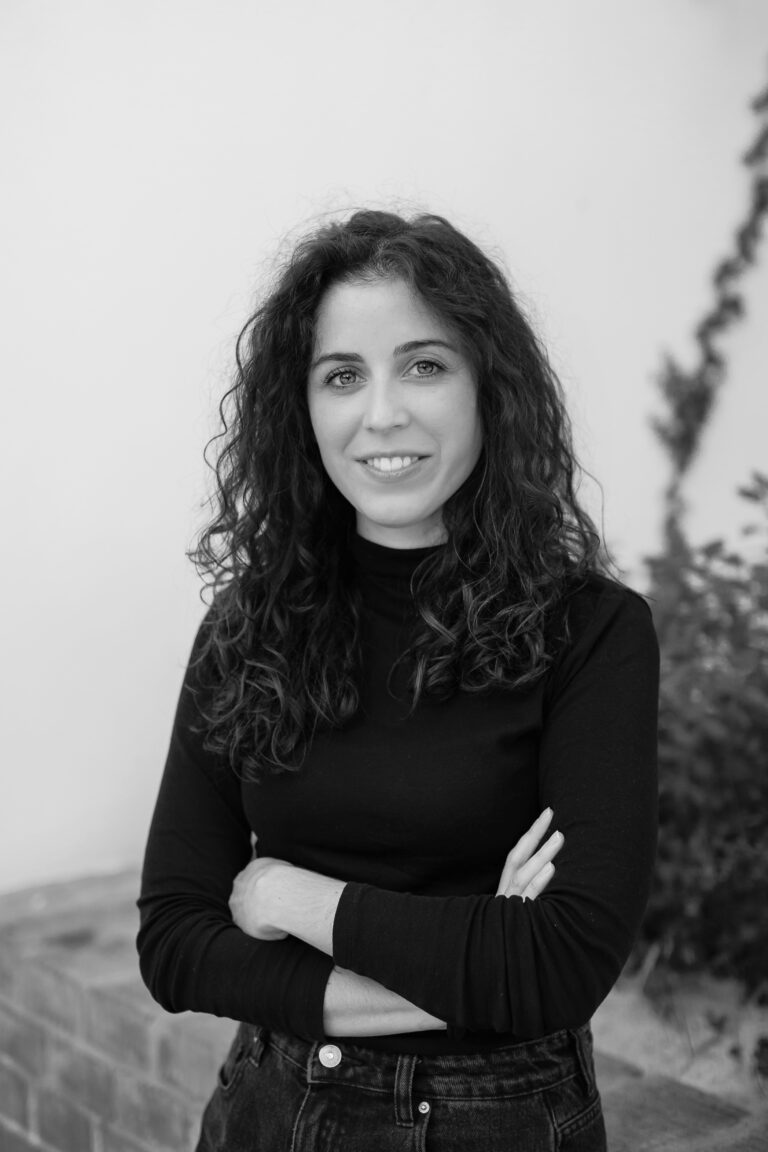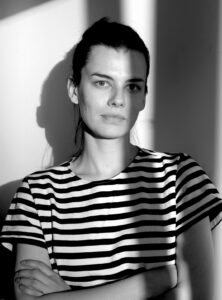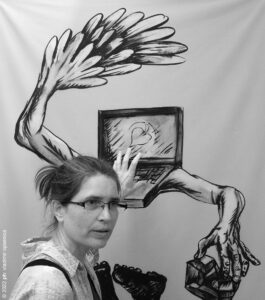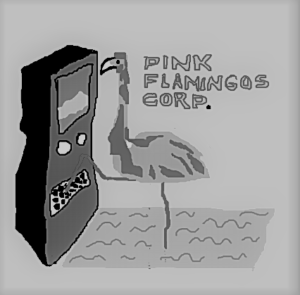Renáta Pintérová

– born 1991. She graduated from the Academy of Fine Arts and Design, Studio of Intermedia in the Studio Image / Sound / Text and Context under the guidance of Nóra Ružičková and Maja Štefančíková, in Bratislava in 2018. She studied the Video Studio tutored by Martin Zet, Jan Šrámek and Martin Mazanec at the Faculty of Fine Arts in Brno. She is in her work interested in the possibilities of subversive approaches to contemporary visual culture, closely interconnected with the world of technology, media, and our lives. This also relates to the attention she pays to the aesthetics of new materialism and new objectivity. In the line of postcolonial thinking, she deals with the themes of rituals, sports, ecology, meta-space, and many other issues. From scientific knowledge and facts, Renáta Pintérová selects topics that interest her and then abstracts them and examines them in the form of video performances and object installations, verifying hereby their universally accepted validity. She is an active member of the performative group Marína Abramovič does not clean up after herself (Marína Abramovič Po Sebe Neupratuje).
My artistic practice is a process of search that is constantly transformed. So far, it has two phases — as a student at Academy of Fine Arts and Design in Bratislava and Faculty of Fine Arts in Brno, I have been absorbing information like a sponge for years, not only from teachers but also from the Internet. Academic stress sometimes had a different effect on the development of the search. Since I graduated, I am in such a vegetative state, I have not stopped looking and experimenting because I am enjoying it. I tried to create and complete residencies after school, “as one is supposed to when one build one´s artistic practice”. Residencies and internships have given me a good experience in networking and learning about art scenes. I just feel that at school a person feels like on an island or like in an experimental laboratory where she is being taken care of and where she has some temporary solid ground under their feet. After school, I feel more like a sailor who sees no horizon or island but enjoys sailing on water.
Being an artist is only one part of my identity. For the last two years, after completing my master’s degree at the Academy of Fine Arts and design, I have been working at an elementary art school 5 days a week. I perceive my female identity as well as my national identity very fluidly. I mean, I feel like a woman, but not so socially established. I perceive the archetypes of both woman and man in myself. But I think identity is something else, something that is neither feminine nor masculine. These are just various manifestations of energy in the body and consciousness, which are constantly changing and transformed during the development of the individual in the female or male body, and which are influenced socially and physiologically. I feel myself like a creative individual who is globalized. I perceive my national identity in the same way. My parents are half Slovaks and half Hungarians. I studied at a Slovak school, but I also speak and think in Hungarian. I feel completely no roots. I do not identify with any nation or national identity. I think it is good thing, as I can identify with something that exists outside of national identity.
In my diploma thesis Flow, created in collaboration with performer Mária Ukropcová, I set a series of three choreographic performances. I used video to explore the identity of the exhibition space and its historical memory by remediation through the performative movement of the body and objects. The aim of this work was to performatively create visual and semantic parallels across different time layers. Through movement, associatively, and thus nonlinearly, it connects the various “events” that shaped the history of museum space, the spectator subject, and the forms of temporality and spatiality within Western culture.
What interests me most in my artistic practice is the subversion within the dominant common social values and representations and conventional systems in the artistic practice and everyday life – the subversion of the visual and aesthetic forms and materials that were and are here now and that shape various manifestations of contemporary art. As well I am interested in the study of common forms within the theory and language of contemporary art, which I filter through my own everyday life. I see my practice as a form of meta-artistic practice — getting out of myself. Search, research, experimentation, questioning, cancellation. Cycle. Cyclic inter-textuality. Hyperlink. Identity between everyday life and artistic practice. I understand artistic research as an open field for endless experimentation within language, various media, materials that create a visual representation of a work — a project — an artistic practice. It is a constant process in motion.
In general, I perceive art as a very important aspect of our reality. I think that it gives society surplus value and pushes the boundaries of everyday, common, known, and physical. It exists in space-time, where there are no boundaries, and it represents an open field that can connect different disciplines and cultures. If there was no art, there would be great emptiness and boredom. I think art is a complementary abstraction of reality. It often gives interesting views / possibilities, to address political, social, and other societal issues. It enables different views of reality and everyday life.
The text was written in collaboration with Denisa Tomková (2021).
– sa narodila v roku 1991. Vysokú školu výtvarných umení ukončila v roku 2018 v odbore Intermédiá v Ateliéri Obraz/zvuk/text a kontext pod vedením Nóry Ružičkovej a Maji Štefančíkovej. Na Fakulte výtvarných umení v Brne študovala v Ateliéri videa u Martina Zeta, Jana Šrámka a Martina Mazanca. V tvorbe ju zaujímajú možnosti subverzívnych prístupov k súčasnej vizuálnej kultúre, úzko prepojenej so svetom technológií, médií a našich životov s nimi, s čím súvisí aj pozornosť, ktorú venuje estetike nového materializmu a novej objektovosti. V línii postkoloniálneho myslenia sa zaoberá témami rituálov, športu, ekológie, meta-priestoru a mnohými inými problematikami. Z vedeckých poznatkov a skutočností vyberá témy, ktoré ju zaujmú a následne ich abstrahuje a skúma v podobe video performancií a objektových inštalácií, preverujúc ich univerzálne prijímanú platnosť. Je aktívnou členkou performatívnej skupiny Marína Abramovič Po Sebe Neupratuje.
Moja umelecká prax je pre mňa proces hľadania, ktorý sa neustále transformuje. Zatiaľ má dve fázy—počas štúdia na VŠVU aj na FAVU, som roky nasávala informácie ako špongia, nielen od pedagógov, ale aj z internetu. Akademický stres niekedy inak pôsobí na vývoj hľadania. Momentálne po škole som v takom vegetatívnom stave. Odkedy som skončila školu, neprestala som hľadať a experimentovať, lebo ma to baví. Snažila som sa tvoriť a absolvovať rezidencie po škole, “ako sa patrí pri budovaní umeleckej praxe”. Rezidencie a stáže mi dali dobrú skúsenosť v networkingu a v spoznávaní umeleckých scén. Len mám pocit, že na škole sa cíti človek ako na nejakom ostrove alebo ako v nejakom experimentálnom laboratóriu, kde ho sledujú, a kde má nejakú dočasnú pevnú pôdu pod nohami. Po škole sa cítim skôr ako moreplavec, ktorý nevidí žiaden horizont ani ostrov, ale baví ho plaviť sa na vode.
Byť umelkyňou je len jednou časťou mojej identity. Posledné dva roky, po ukončení magisterského štúdia na VŠVU, pracujem na základnej umeleckej škole 5 dní v týždni. Svoju identitu ženy ako aj svoju národnú identitu vnímam veľmi fluidne. Teda, cítim sa ako žena, ale nie tak ustanovene spoločensky. Pociťujem v sebe archetypy ženy aj muža. Ale myslím si, že identita je niečo iné, niečo čo nie je ženské ani mužské. Sú to len rôzne prejavy energie v tele a vedomí, ktoré sa neustále menia a transformujú počas vývoja jedinca v ženskom alebo mužskom tele, a ktoré sú ovplyvnené spoločensky aj fyziologicky. Cítim sa ako kreatívny jedinec, ktorý je globalizovaný. Rovnako vnímam svoju národnú identitu. Moji rodičia sú napoly Slováci a Maďari. Študovala som v slovenskej škole, ale rozprávam aj premýšľam v maďarčine. Cítim sa úplne bez koreňov. So žiadnym národom ani národnou identitou sa nestotožňujem. Myslím si, že je to dobré, lebo sa stotožňujem s niečím, čo existuje mimo národnú identitu.
Vo svojej diplomovej práci Flow som v spolupráci s performerkou Máriou Ukropcovou vytvorila sériu troch choreografických performance. Táto práca prostredníctvom videa skúma identitu výstavného priestoru a jeho historickú pamäť remediáciou cez performatívny pohyb tela a objektov. Zámerom tejto práce bolo performatívne vytváranie vizuálnych a významových paralel naprieč rôznymi časovými vrstvami. Prostredníctvom pohybu tak asociatívne, a teda nelineárne, prepája rôzne „udalosti“, ktoré utvárali históriu muzeálneho priestoru, diváckeho subjektu a podôb časovosti a priestorovosti v rámci západnej kultúry.
To, čo ma najviac zaujíma v mojej umeleckej praxi je subverzia dominantných zaužívaných spoločenských hodnôt, reprezentácií a konvenčných systémov umeleckej praxe aj každodennosti, podvracanie vizuálnych a estetických foriem a materiálov, ktoré tu boli a sú tu aj teraz a formujú rôzne prejavy súčasného umenia. A rovnako skúmanie zaužívaných foriem v rámci teórie a jazyka súčasného umenia, ktoré filtrujem cez svoju vlastnú každodennosť. Svoju prax vidím ako formu meta-umeleckej praxe—vystúpenie zo seba samej. Hľadanie, výskum, experimentovanie, spochybnenie, zrušenie. Cyklus. Cyklická intertextualita. Hyperlink. Identita medzi každodennosťou a umeleckou praxou. Umelecký výskum chápem ako otvorené pole pre nekonečné experimentovanie v rámci jazyka, rozličných médií, materiálov, ktoré vytvárajú vizuálnu reprezentáciu diela—projektu—umeleckej praxe. Je to neustály proces v pohybe.
Vo všeobecnosti vnímam umenie ako veľmi dôležitý aspekt našej reality. Myslím si, že spoločnosti dáva nadhodnotu a posúva hranice každodenného, zaužívaného, poznaného aj fyzického. Existuje v časopriestore, kde nie sú hranice a predstavuje otvorené pole, ktoré môže spájať rôzne odbory, disciplíny, kultúry. Ak by nebolo umenie, bola by tu veľká prázdnota a nuda. Myslím si, že umenie je komplementárna abstrakcia reality. Častokrát dáva zaujímavé pohľady/možnosti na riešenie politických, sociálnych a iných spoločenských problémov. Umožňuje iné pohľady na realitu a každodennosť.
Text bol napísaný v spolupráci s Denisou Tomkovou (2021).


